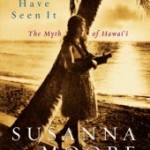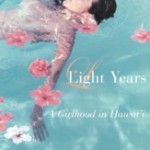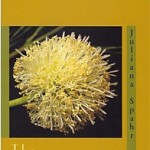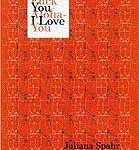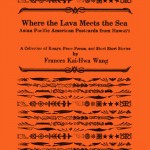Panax Ginseng is a bi-monthly column by Henry W. Leung exploring linguistic and geographic borders in Asian American literature, especially those with hybrid genres, forms, vernaculars, and visions. The column title suggests the English language’s congenital borrowings and derives from the Greek panax, meaning “all-heal,” together with the Cantonese jansam, meaning “man-root.” This perhaps troubling image of one’s roots as panacea informs the column’s readings.
*
*
It is by speaking of the “assumption of the myths of a race not [her] own, a race nearly annihilated by [her] kind” that Susanna Moore begins her quasi-memoir, I Myself Have Seen It: The Myth of Hawai‘i (National Geographic 2003). She describes her “self-delighting pride at being a liminal participant in an authentic culture that continues, despite attempts to the contrary, to fear the ghostly night marchers . . .” This prefatory remark appears to apologize for her presumptions as a white woman writing about an island where she grew up with considerable privilege. Yet, notice the qualifiers—“self-delighting,” “liminal,” “authentic”—as they progress from the private to the public along a claim toward ownership. Identity politics frustrate me to no end, but as poetry and nonfiction on the subject of Hawaii have been coming across my desk recently, I have started to see that perhaps nobody can uncontestably write or rewrite Hawaii, not even those with genealogical ties to the native Hawaiians: for to call them natives today is to codify culture into a prelapsarian nostalgia, to selectively deny cultural change. I also wonder about recent mainland literatures about Hawaii and to what degree their conservatism and transgressions are intrinsic. I intend to look briefly here at three writers who claim a conflicted connection to Hawaii through the tension of poetic language: Susanna Moore, who lived on Oahu from early adolescence until she was a teenager; Juliana Spahr, who taught at the University of Hawaii at Manoa for half a decade; and Frances Kai-Hwa Wang, who has been “going home” to the Big Island from the Midwest since her parents retired there. Each of their works brushes against the usual tropes that brand a Hawaiian text when written in English, such as provincial or pastoral expectations, a stylized pidgin lexicon, and a mystified engagement with history. Yet, our three writers clearly feel their outsiderness, and, in order to make meaning and make meaning communicable as required by their poetics, they find nuanced rhetorical forms to grant themselves permission.
Though Susanna Moore is primarily a novelist, I engage with her two quasi-memoirs here because they don’t function as histories in the formal sense, nor do they paint the personal history that we would expect from a narrative memoir. Rather, her approach to Hawaii on the page utilizes a technique of accumulation and parataxis more common to poetry than to prose. Each of the chapters in I Myself Have Seen It is titled with a definite article (“The Night Marchers,” “The Returning God,” “The Islands,” etc.) and recaps a moment in Hawaii’s history by culling together anecdotal documents, often sparking or rhyming with associations to corollaries like those of Greek mythology. Moore’s personal experiences emerge more frequently toward the end, so that, taken in sum, the book appears to move along a linear history. Taken in parts, however, the material is fragmentary rather than episodic. It offers discrete moments of intense attention or, more often, intense spectacle. The narratives are sparks of observation, just as watching and witness are thematically key to the process.
This method is even more pronounced in Moore’s later, also quasi-, memoir entitled Light Years: A Girlhood in Hawaii (Grove Press 2008), whose title brings to mind the myth-memoir style of Maxine Hong Kingston’s Woman Warrior: Memoirs of a Girlhood Among Ghosts. In Light Years, every chapter is again light on personal memoir and composed largely of excerpts on common island themes. These are drawn from Moore’s childhood library, which means they are nearly all Western authors, from Herodotus and Hesiod to Dickinson and Woolf, and they also include excerpts from her own fiction. For a writer who has spent considerable time on the islands and engaged extensively with the space in her first three novels, both Light Years and I Myself are remarkably evasive and reticent. This evasion on the macro/formal level perhaps bespeaks Moore’s anxieties on the micro/sentence level. By calling on other writers to speak for Hawaii (or to speak around Hawaii, as in Light Years, which is composed more thematically than geographically), Moore relinquishes the pressure to give her own nonfictional account of it. Citing passages from her own fiction is also a part of this evasion. What I understand less are the passages in which she plagiarizes herself—verbatim, for as much as two pages at a time—without citing herself as a source. This includes a sustained observation about Japanese girls on the beach cut from I Myself and pasted into Light Years. I can’t tell if this is laziness or a codification of voice, as though her own history were untouchable myth, impossible to revise or rephrase. She writes in Light Years: “I did not want to make the mistake of imagining that myth was something available to everyone. I understood that myth was a luxury.” Regardless, the result is a polyphonic collage, and I read the poetic process as a cadavre exquis.
Juliana Spahr’s writing is much more direct in its tensions, taking on a form of anaphoric self-contradiction. In her “barely truthful” novel/memoir/prose-poem The Transformation (Atelos 2007), Spahr engages directly with her anxieties about the expansionist and colonial language she cannot but use. The book begins: “Flora and fauna grow next to and around each other without names. Humans add the annotation.” Rather than annotate, Spahr refuses to name Hawaii explicitly—or any person or place—except in the afterword. She names only by allusion, by mapping outlines or negative space to suggest a recognizable form without claiming ownership over it. When she is naming or nominalizing, she makes a point of reconfiguring her nouns until they become unfamiliar and questionable: “the boths,” “the accusative they,” and the persistent unease in which “they could not allow themselves to be an us.” Of her complicity as a mainland writer coming to Hawaii, she notes: “There was no way that the expansionist language could carry all the local knowledge because the expansionist language was only able to be expansionist because it claimed to be universal, neutral, objective, because it did not name the winds so specifically.” Her unfolding repetitions are carried over from her earlier book of poems, Fuck You-Aloha-I Love You (Wesleyan 2001), the title of which is an example of placeholder words being transfigured. A significant motif in those poems is “da kine,” a Hawaiian pidgin catch-all that can refer to nearly anything and cannot be reduced to a single part of speech.
The primary conflict of The Transformation is expression itself, which is tantamount to the capacity to belong. However, though the quest in the book and in the poems are ostensibly a single, singular transformation, this proves to be not only implausible but likened to the process of conversion or conquest, to the illusion that a tourist can fly to Hawaii, write “747 poems” so named after the commercial jet plane, and simply fly away. Formally, Spahr achieves her transformation by a stop-start process of pivots, disruptions, and uncertainties. She writes, “they continued to circle around and around in their thinking and the sun shone down and their skin sometimes tanned and their skin sometimes burned.” Unable to speak for or with Hawaii except in a language problematic for its colonial past, she works at a keenly microscopic level, which calls for a new method of topography, “a new sort of conceptualization that allowed for more going astray than any map they had ever seen.”
Frances Kai-Hwa Wang’s chapbook, Where the Lava Meets the Sea (Blacklava 2013), is the most self-disclosing of the texts discussed here. Wang’s approach attempts inclusion in spite of otherness, and the subtitle of her chapbook—Asian Pacific American Postcards from Hawai‘i—is telling, significant for a lyric speaker whose home base is the Midwest and who finds community in Hawaii’s immigrant, rather than indigenous, population. Wang’s prose poems are postcards not only in their snapshot form, but also in that they inevitably tokenize something of the other. They frequently feature surprise at cultural norms, delineating the “Culture of a Kiss” or “Culture on a Volcano,” sometimes enumerating a menu of exotic items (“tempura, teriyaki chicken, mochi, andago, anpan, Spam musubi”), and at other times featuring projected rites of initiation (“What kind of Hawaiian are you?”), but above all else, just as in the other texts, they express a desire to be considered by the subject community as more than an intruder. Wang romanticizes the hybridity of Hawaii and finds respite there by blending into its Asian American community in a way that she cannot in the Midwest: “I am tired of singing and dancing and always being the one to teach others about our culture(s) and justify how we are not weird. Sometimes I wish I could just live my life without having to think about culture . . .”
Contrary to this professed sentiment that culture is anything but neutral, what is ultimately remarkable about Wang’s poetry postcards is their consistent tone of wonder. In the tense space of the unfamiliar, Wang does not evade it like Moore or become agitated like Spahr, but delights in its otherness. The last line of the chapbook illustrates this when the speaker sees “a school of flying fish take flight out of the water into our world.” Wang watches in melancholy pleasure as her son tries to fit in with other children, when she watches herself as both observer and performer in a place where her identity is amplified by scrutiny, when she ventriloquizes a local voice through such lines as: “But hooo! Braddah! That’s the stuff love songs are made of.” In her aesthetic I see an attempt to go beyond politics (the “having to think about culture”) by incorporating pidgin not as a foreign language but as a speech pattern, a syntax for her own use as song.
I am tempted to use some spectrum of truth or authenticity to rank these approaches to writing Hawaii as an outsider. Instead, I’ll return to the passage I opened with from Moore’s I Myself Have Seen It, about the assumption of others’ myths. When I read the phrase, “an authentic culture that continues, despite attempts to the contrary, to fear,” I can almost see authenticity being equated with fear. The night marchers stand in for elemental forces which cannot be fully named nor reckoned, and fear cannot be tempered by logic or criticism. I hypothesize that authenticity may be nothing more than adrenaline: out of our control, stimulated by a fraught circumstance, and, of necessity, charged for motion or transformation because the naming always happens and then re-happens. Is this not poetry in its many forms? In its renewal? A poetics on the subject of Hawaii naturally comes with old tropes of the wonders of the other, but I argue that it is also a matter of the other wondering at. I began with the concept of permission and ownership, but perhaps as writers, we neither make nor issue permissions. Discomfort and otherness are the beginnings of art. Spahr writes of “a time of troubled and pressured pronouns,” but she also writes of “a story of finding an ease in discomfort. And a catalogue of discomfort.” Perhaps it is exactly trouble that is sought when writing of the exotic; we write best of resorts by re-sorting, even though we come short always by resorting to.
